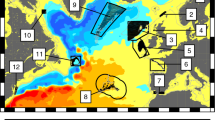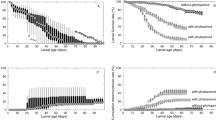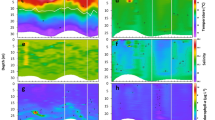Abstract
Larval dispersal is the process enabling connectivity between populations of marine species with a sedentary adult stage. This transportation results from the coupling between flow and larval biological traits. This experimental study aims to quantify these larval biological traits, namely pelagic larval duration (PLD), buoyancy and larval vertical motility behavior, for Corallium rubrum. Larval vertical motility behavior was split into active behavior (swimming) and passive behavior (free fall). A particle-tracking routine was applied to video recordings of the active and passive motility behavior of C. rubrum larvae to quantify their free fall speeds, swimming activity frequency and swimming speeds. The experiment was repeated under different light conditions and at different larval ages. PLD ranged from 16 days (95 % survival) to 42 days (5 % survival). Larvae exhibited negative buoyancy with a free fall speed decreasing linearly with age, at a velocity varying from −0.09 ± 0.026 cm s−1 on day 1 to −0.05 ± 0.026 cm s−1 on day 10. No significant difference was found either in the activity frequency or in the mean swim velocities during active periods for age (up to 12 days old) or under different light conditions. C. rubrum larvae maintained active swimming behavior for 82 % of the time. This activity frequency was combined with age-varying free fall periods in the motility behavior model extrapolated up to 15 days old, resulting in a mean upward speed that increased from 0.045 cm s−1 (day 1) to 0.056 cm s−1 (day 15). This larval motility behavior, combined with the extended PLD, confers on C. rubrum larvae an unsuspectedly high dispersive potential in open waters.




Similar content being viewed by others
References
Arnold SN, Steneck RS (2011) Settling into an increasingly hostile world: the rapidly closing “recruitment window” for corals. PLoS One 6(12):e28681. doi:10.1371/journal.pone.0028681
Ben-David-Zaslow R, Benayahu Y (1998) Competence and longevity in planulae of several species of soft corals. Mar Ecol Prog Ser 163:235–243
Bingham R, Young CM (1991) Larval behavior of the ascidian Ecteinascidia turbinata Herdman: an in situ experimental study of the effects of swimming on dispersal. J Exp Mar Biol Ecol 145:189–204
Bramanti L, Magagnini G, De Maio L, Santangelo G (2005) Recruitment, early survival and growth of the mediterranean red coral Corallium rubrum (L. 1758), a 4-year study. J Exp Mar Biol Ecol 314:69–78
Bramanti L, Iannelli M, Santangelo G (2009) Mathematical modelling for conservation and management of gorgonians corals: youngs and olds, could they coexist? Ecol Model 220:2851–2856
Bramanti L, Vielmini I, Rossi S, Stolfa S, Santangelo G (2011) Involvement of recreational scuba divers in emblematic species monitoring: the case of Mediterranean red coral (Corallium rubrum). J Nat Conserv 19:312–318
Bramanti L, Vielmini I, Rossi S, Tsounis G, Iannelli M, Cattaneo-Vietti R, Priori C, Santangelo G (2014) Demographic parameters of two populations of red coral (Corallium rubrum) in the North Western Mediterranean. Mar Biol 161:1015–1026
Charles S, Jordana E, Amoroux JM, Gremare A, Desmalades M, Zudaire L (2003) Reproduction, recruitment and larval metamorphosis in the serpulid polychaete Ditrupa arietina (OF Muller). Estuar Coast Shelf Science 57(3):435–443. doi:10.1016/S0272-7714(02)00372-4
Chia FS, Buckland-Nick J, Young CM (1984) Locomotion of marine invertebrate larvae: a review. Can J Zool 62:1205–1222
Costantini F, Fauvelot C, Abbiati M (2007) Fine-scale genetic structuring in Corallium rubrum: evidence of inbreeding and limited effects of larval dispersal. Mar Ecol Prog Ser 340:100–119
Costantini F, Taviani M, Remia A, Pintus E, Schembri PJ et al (2010) Deep-water Corallium rubrum (L., 1758) from the Mediterranean Sea: preliminary genetic characterisation. Mar Ecol 31:261–269. doi:10.1111/j.1439-0485.2009.00333.x
Cowan JH, Houde ED, Rose KA (1996) Size-dependent vulnerability of marine fish larvae to predation: an individual-based numerical experiment. ICES J Mar Sci 53:23–37
Cowen RK, Sponaugle S (2009) Larval dispersal and marine population connectivity. Ann Rev Mar Sci 1:443–466
Cowen RK, Lwiza KMM, Sponaugle S, Paris CB, Olson DB (2000) Connectivity of marine populations: open or closed? Science 287:857–859
Crean AJ, Marshall DJ (2009) Coping with environmental uncertainty: dynamic bet hedging as a maternal effect. Philos Trans R Soc B 364:1087–1096
Cumbo VR, Fan TY, Edmunds PJ (2012) Physiological development of brooded larvae from two pocilloporid corals in Taiwan. Mar Biol 159:2853–2866
Dahan M, Benayahu Y (1998) Embryogenesis, planulae longevity, and competence in the octocoral Dendronephthya hemprichi. Invertebr Biol 117(4):271–280
Figueiredo J, Baird AH, Cohen MF, Flot JF, Kamiki T, Meziane T, Tsuchiya M, Yamasaki H (2012) Ontogenetic change in the lipid and fatty acid composition of scleractinian coral larvae. Coral Reefs 31:613–619
Garrabou J, Harmelin JG (2002) A 20-year study on life-history traits of a harvested long-lived temperate coral in NW Mediterranean: insights into conservation and management needs. J Anim Ecol 71:966–968
Gili JM, Coma R (1998) Benthic suspension feeders in marine food webs. Trends Ecol Evol 13:297–337
Graham EM, Baird AH, Connolly SR, Sewell MA, Willis BL (2013) Rapid declines in metabolism explain extended coral larval longevity. Coral Reefs 32:539–549
Guizien K, Brochier T, Duchêne JC, Koh BS, Marsaleix P (2006) Dispersal of Owenia fusiformis larvae by wind-driven currents: turbulence, swimming behaviour and mortality in a three-dimensional stochastic model. Mar Ecol Prog Ser 311:47–66
Guizien K, Belharet M, Guarini JM, Marsaleix P (2012) Using larval dispersal simulations for marine protected area design: application to the Gulf of Lions (northwest Mediterranean). Limnol Oceanogr 57(4):1099–1112
Guizien K, Belharet M, Moritz C, Guarini JM (2014) Vulnerability of marine benthic metapopulations: implications of spatially structured connectivity for conservation practice. Divers Distrib. doi:10.1111/ddi.12254
Harii S, Kayanne H, Takigawa H, Hayashibara T, Yamamoto M (2002) Larval survivorship, competency periods and settlement of two brooding corals, Heliopora coerulea and Pocillopora damicornis. Mar Biol 141:39–46
Harii S, Nadaoka K, Yamamoto M, Iwao K (2007) Temporal changes in settlement, lipid content and lipid composition of larvae of the spawning hermatypic coral Acropora tenuis. Mar Ecol Prog Ser 346:89–96
Isomura N, Nishihira M (2001) Size variation of planulae and its effect on the lifetime of planulae in three pocilloporid corals. Coral Reefs 20:309–315
Jones GP, Almany GR, Russ GR, Sale PF, Steneck RS, van Oppen MJH, Willis BL (2007) Larval retention and connectivity among populations of corals and reef fishes: history, advances and challenges. Coral Reefs 28:307–325
Kelly RP, Palumbi SR (2010) Genetic structure among 50 species of the north-eastern Pacific rocky intertidal community. PLoS One 5:e8594
Ledoux J, Garrabou J, Bianchimani O, Drap P, Feral JP, Aurelle D (2010) Fine-scale genetic structure and inferences on population biology in the threatened Mediterranean red coral, Corallium rubrum. Mol Ecol 19:4204–4216
Lee RF, Hagen W, Kattner G (2006) Lipid storage in marine zooplankton. Mar Ecol Prog Ser 307:273–306
Lett C, Verley P, Mullon C, Parada C, Brochier T, Penven P, Blanke B (2008) A Lagrangian tool for modelling ichthyoplankton dynamics. Environ Model Softw 23(9):1210–1214
Levin LA (1990) A review of methods for labeling and tracking marine invertebrate larvae. Ophelia 32:115–144
Levin LA (2006) Recent progress in understanding larval dispersal: new directions and digressions. Integr Comp Biol 46(3):282–297
Linares C, Garrabou J, Hereu B, Diaz D, Marschal C, Sala E, Zabala M (2012) Assessing the effectiveness of marine reserves on unsustainably harvested long-lived sessile invertebrates. Conserv Biol 26:88–96
Lipcius RN, Eggleston DB, Schreiber SJ, Seitz RD, Shen J, Sisson M, Stockhausen WT, Wang HV (2008) Importance of metapopulation connectivity to restocking and restoration of marine species. Rev Fish Sci 16(1–3):101–110
Lowe WH, Allendorf FW (2010) What can genetics tell us about population connectivity? Mol Ecol 19:3038–3051
Mc Edward LR (1995) Ecology of marine invertebrate larvae. CRC Press, Boca Raton
Mileikovsky SS (1973) Speed of active movement of pelagic larvae of marine bottom invertebrates and their ability to regulate their vertical position. Mar Biol 23:11–17
Moran PJ, De’ath G, Baker VJ, Bass DK, Chistie CA, Miller IR, Miller-Smith BA, Thompson AA (1992) Pattern of outbreaks of crown-of thorns starfish (Acanthaster planci L.) along the Great Barrier Reef since 1966. Aust J Mar Freshw Res 43:555–568
Palumbi SR (2003) Population genetics, demographic connectivity and the design of marine reserves. Ecol Appl 13:S146–S158
Paris CB, Helgers J, van Sebille E, Srinivasan A (2013) Connectivity modeling system: a probabilistic modeling tool for the multi-scale tracking of biotic and abiotic variability in the ocean. Environ Model Softw 42:47–54
Pawlik JR, Butman CA (1993) Settlement of a marine tube worm as a function of current velocity: interacting effects of hydrodynamics and behavior. Limnol Oceanogr 38(8):1730–1740
Pennington JT, Emlet RB (1986) Ontogenic and diel vertical migration of a planktonic echinoid larva, Dendraste rexcentricus (Eschscholtz): occurrence, causes, and probable consequences. J Exp Mar Biol Ecol 104:69–95
Planes S, Jones GP, Thorrold SR (2009) Larval dispersal connects fish populations in a network of marine protected areas. Proc Nat Acad Sci USA 106:5693–5697. doi:10.1073/pnas.0808007106
Queiroga H, Blanton J (2004) Interactions between behavior and physical forcing in the control of horizontal transport of decapod crustacean larvae. Adv Mar Biol 47:107–214
R Core Team (2014) R: a language and environment for statistical computing. http://www.R-project.org
Rossi S, Tsounis G, Orejas C, Padrón T, Gili JM, Bramanti L, Teixidó N, Gutt J (2008) Survey of deep-dwelling red coral (Corallium rubrum) populations at Cap de Creus (NW Mediterranean). Mar Biol 152:429–439
Santangelo G, Carletti E, Maggi E, Bramanti L (2003) Reproduction and population sexual structure of the overexploited Mediterranean red coral Corallium rubrum. Mar Ecol Prog Ser 248:99–108
Santangelo G, Bramanti L, Iannelli M (2007) Population dynamics and conservation biology of the overexploited Mediterranean Red coral. J Theor Biol 244:416–423
Schwindt E (2007) The invasion of the acorn barnacle Balanus glandula in the south-western Atlantic 40 years later. J Mar Biol Assoc 87:1219–1225
Seger J, Brockmann HJ (1987) What is bet-hedging? In: Harvey PH, Partridge L (eds) Oxford surveys in evolutionary biology, vol 4. Oxford University Press, Oxford, pp 182–211
Shanks AL (2009) Pelagic larval duration and dispersal distance revisited. Biol Bull 216:373–385
Shanks AL, Grantham BA, Carr MH (2003) Propagule dispersal distance and the size and spacing of marine reserves. Ecol Appl 13:159–169
Sier CJS, Olive PJW (1994) Reproduction and reproductive variability in the coral Pocillopora verrucosa from the Republic of Maldives. Mar Biol 118:713–722
Stearns SC (1976) Life-history tactics: a review of the ideas. Q Rev Biol 51:3–47
Stearns SC (1992) The evolution of life histories. Oxford University Press, Oxford
Theodor J (1967) Contribution à l’étude des gorgones (VII): écologie et comportement de la planula. Vie Milieu 18:291–300
Thorson G (1946) Reproduction and larval development of Danish marine bottom invertebrates, with special reference to the planktonic larvae in the Sound (Øresund). Meddelelser fra Kommissionen for Danmarks Fiskeri Og Havundersögelser, Serie: Plankton 4:1–523
Tsounis G, Rossi S, Grigg R, Santangelo G, Bramanti L, Gili JM (2010) The exploitation and conservation of precious corals. Oceanogr Mar Biol Annu Rev 48:161–212
Vighi M (1972) Etude sur la reproduction du Corallium rubrum (L.). Vie Milieu 23:21–32
Vogel S (1994) Life in Moving Fluids, 2nd edn. Princeton University Press, Princeton
Weinberg S (1979) The light dependent behaviour of planulae larvae of Eunicella singularis and Corallium rubrum and its implications for octocorallian ecology. Bijdr Dierkd 49:16–30
Wheeler JD, Helfrich KR, Anderson EJ, McGann B, Staats P, Wargula AE, Wilt K, Mullineaux L (2013) Upward swimming of competent oyster larvae Crassostrea virginica persists in highly turbulent flow as detected by PIV flow subtraction. Mar Ecol Prog Ser 488:171–185
Winet H (1973) Wall drag on free-moving ciliated microorganisms. J Exp Biol 59:753–766
Acknowledgments
We thank the captain and crew of the RV Nereis II, and the scuba divers, JC Roca and B Hesse, for their technical assistance during field sampling. This work was funded by the French National Program LITEAU IV of the Ministère de l’Ecologie et de l’Environnement Durable under project RocConnect—Connectivité des habitats rocheux fragmentés du Golfe du Lion (de Marseille au Cap de Creus) et son rôle dans la persistence régionale de trois espèces de gorgonaires (PI, K. Guizien, Project Number 12-MUTS-LITEAU-1-CDS-013). Participant’s travels between France and Spain were supported by bilateral grant CNRS/CSIC under project Gorgol (Grant Number, 25331). This work is a partial fulfillment of the PhD Thesis of N. Viladrich (Project BENTOLARV, Grant Number, CTM2009-10007) who is supported by a doctoral fellowship from the Universitad Autónoma de Barcelona. L Bramanti was supported by a Marie Curie Intra European Fellowship within the Seventh European Community Framework Programme (Project CORGARD, Grant Number, 221072). We would like to thank Proof-reading-service.com for English edition and corrections of the manuscript. Our thanks to the two anonymous referees and the associate editor for helpful comments and advices.
Author information
Authors and Affiliations
Corresponding author
Additional information
Communicated by M. A. Peck.
Electronic supplementary material
Below is the link to the electronic supplementary material.
Rights and permissions
About this article
Cite this article
Martínez-Quintana, A., Bramanti, L., Viladrich, N. et al. Quantification of larval traits driving connectivity: the case of Corallium rubrum (L. 1758). Mar Biol 162, 309–318 (2015). https://doi.org/10.1007/s00227-014-2599-z
Received:
Accepted:
Published:
Issue Date:
DOI: https://doi.org/10.1007/s00227-014-2599-z




